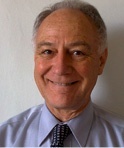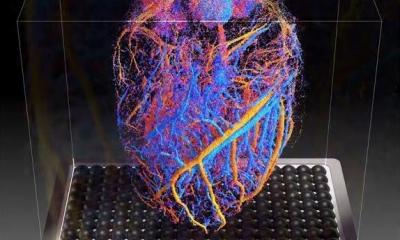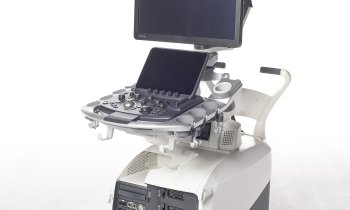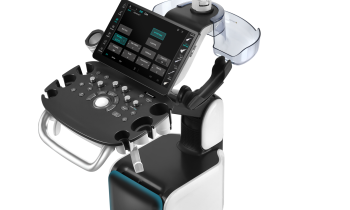Liver fibrosis emerges as a breakthrough for elastography
‘Elastography is in a position much like Doppler 20 years ago,’ according to David Cosgrove, BMBCh, MA, FRCR, FRCP, Professor of Clinical Ultrasound at Imperial College School of Medicine in London.

‘Back then Doppler was new and people were excited about it. They wouldn’t buy a high-end machine without the capability. Yet they didn’t a quite know what they would do with it. That’s now the situation with elastography.’
A renowned expert in ultrasound, Prof. Cosgrove has authored numerous publications and is a key contributor to the ‘Guidelines and Recommendations on the Clinical Use of Ultrasound Elastography’ from the European Federation of Societies for Ultrasound in Medicine and Biology (EFSUMB) that spells out the basic principles and technology as well as the clinical applications of ultrasound elastography. In a similar effort, he helped compile guidelines for the World Federation for Ultrasound in Medicine and Biology (WFUMB), with publication expected later this year.
‘The guidelines have been effective in getting people launched in the right direction, suggesting where to put their efforts, as well as helping to know what has been found wanting,’ he explained, adding that they also provide a good meta-analysis, with the writers of each section summarising the available literature and adding their own experience.
According to the professor, the reason for the uneven adoption of elastography is that the quality is extremely variable: ‘There are so many technologies, some good, some very good, whilst in others the results seem random, in some cases regrettably rather poor.’
The turning point in the wide adoption of colour Doppler came with deep vein thrombosis (DVT) when it became clear that it was a much easier diagnostic technique and gave greater confidence. Once clinicians found it indispensible for this application, they were more assured in applying it elsewhere, Prof. Cosgrove pointed out.
He believes the breakthrough for greater adoption of elastography will come with investigations of liver fibrosis. ‘Classifying this disease is difficult,’ he said. ‘Biopsies are not nearly as easy as in the breast, and take just a tiny sample of a rather large organ, whereas elastography can sample much, much more. There are a lot of reasons why liver elastography is probably going to be the most important and widely used application.’
The United Kingdom’s National Health Service Technology Adoption Centre (NTAC) found ultrasound elastography, using the shear-wave speed technique, ‘enables a non- invasive, and therefore safer, diagnosis and subsequent monitoring of liver fibrosis when compared to the traditional gold standard procedure of liver biopsy.’
NTAC concluded: ‘the findings suggest that for a cohort of 27,620 patients, the estimated number of patients diagnosed with liver disease in England and Wales, implementing ultrasound elastography is predicted to save a total of £14 million, or £520 per patient’.
Benefits to patients included a low risk of complications for the non-invasive procedure, no pain, and an outpatient exam of 15 minutes against a hospital stay of up to three days for biopsy procedures.
‘It is a small study with three centres, not as thorough as NICE (National Institute for Health and Clinical Excellence) would have done, but it is quite a strong recommendation,’ Prof. Cosgrove notes.
For the ultrasound component of the Quantitative Imaging Biomarkers Alliance (QIBA) project sponsored by the Radiological Society of North America (RSNA), the work group also narrowed its focus to liver fibrosis, and also selected the shear wave speed elastography technology.
Ultrasound based platforms in this class include the Fibroscan from Echosens, the Siemens S2000, S3000, Philips iU22, and the Aixplorer from SuperSonic Imagine. All systems are capable of quantifying tissue stiffness, but only two produce an ultrasound image.
‘Siemens’ Acuson S3000 produces a still image on which you can take measurements, whereas SuperSonic’s Imagine’s shear wave elastography technology produces a real-time, moving image, which is a significant improvement and is probably the pre-eminent of the technologies,’ the professor pointed out. The first results of the global QIBA initiative, presented at the RSNA congress in December 2013, showed very low inter-observer variation on phantoms, ‘a reassuring result,’ according to Prof. Cosgrove. Currently a study of so-called confounders, like inflammation and liver congestion, is underway with the Harvard Medical School at the Massachusetts General Hospital. A second generation of phantoms featuring a viscous component that simulates fat content, or steatosis, will now make the rounds of QIBA participating centres worldwide.
Prof. Cosgrove: ‘The overall point is to establish an undisputable clinical application for elastography. Adoption will ripple out from that.’
06.03.2014











